Troubleshooting Manual
Just as with almost any lawn mowing machinery, Scag Lawn Mowers may run into minor issues every once in a while. We’ve designed our troubleshooting manual to help detail all the possible issues that your Scag mower is likely to run into and point out some quick fixes that you might be able to perform yourself.
Remember however that the mower is still a machine and if you’re having difficulty fixing it, it’s always recommended that you take it to your local service center.
Be Safe!
If you’re not qualified to work on your Scag Mower, do not try to repair your machine as you may damage the mower or even put yourself at risk. Lawn mowers are potentially dangerous machines and can induce considerable damage if repairs have not been properly conducted.
- Make sure that children are not present when working on repairs.
- Be alert when operating the mower on a slope or inclined surface.
- Never wear loose fitting clothes when operating your mower.
- Never refill the fuel tank indoors, always refuel outside.
- Check the blades and the discharge tubes occasionally to ensure they are well fastened.
- If you’re unsure about how the mower might respond to unfamiliar obstacles, turn off the blades.
- Clear objects that could be thrown the mower’s blades from the yard before mowing.
- The mower is not designed to carry passengers so never attempt to do this.
- Do not refuel when the engine is hot.
- Do not leave the mower’s engine on when it is going to be left unattended.
Identifying the controls and instruments
Make sure that you’re well aware of all the various controls and switches before operating the mower. Take some time to become familiar with the location and the function of each of the controls as it is necessary for safe, efficient mower operation.
- Ignition switch:
The ignition starter switch is used to turn your engine on. Simply twist the key towards the side to the ‘ON’ position and pull the recoil starter in order to start the engine. - Mower Deck Switch:
The mower’s deck switch can be used to either engage or even disengage the drive system and begin mowing. This can be activated by simply pulling up on the switch and deactivated when you push down the switch. - Engine Choke Control:
Cold weather starts make regular starting difficult and in such a scenario, the engine choke control can be used to start the engine. - Engine Throttle Control:
The engine’s speed can be adjusted using the engine throttle control. To increase the engine speed, simply push the lever forward and pull the lever back in order to decrease the engine’s speed. To idle the engine, pull the lever completely back – push it fully forward to commence cutting. - Steering and Braking:
The mower’s wheels can be controlled using the steering controls, and can also be used to apply the brake or put the machine in reverse gear. - Transmission Shift Lever:
This lever can be used in order to select the running speed or to shift to reverse gear. The machine needs to be brought to a complete stop in order to shift between different gears and to shift to the reverse gear. - Neutral Latch:
The neutral latch enables you to secure the belt drive system in the neutral position. The latches should be engaged when the machine is being parked.
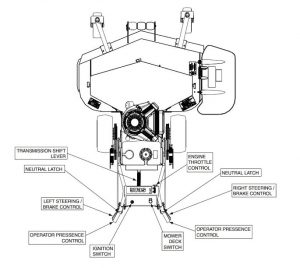
First-time Use Procedures
Before using the Scag mower for the first time, a few procedures must be carried out in order to prepare the mower for optimal operation:
- Ensure that all the belts are properly aligned – check for wear and tear after 2, 4 and 8 hours
- Ensure that you change engine oil as well as the oil filter after 20 hours of use since purchase
- Tighten any loose hardware that you may find on the machine
- Inspect the interlocking system for ideal operation
- Inspect the tire pressure and fill tires if required
Starting The Engine
Follow the below mentioned steps in order to start the engine:
- Ensure that the fuel shutoff valve gas been turned off – the valve is located next to the fuel tank and completely open
- Engage the neutral latch levers
- Shift the mower’s transmission into the neutral setting
- Shift the PTO switch into the deactivated setting.
- If the engine’s temperature is too low, choke the engine in order to improve fuel mixture as needed.
- Shift the engine’s throttle control lever to half engine speed.
- Twist the ignition key to the side to the ‘ON’ position.
- Pull out the recoil starter to start the engine.
- Wait for a while and allow the engine to warm up before commencing mowing
Scag Mower’s basic troubleshooting
It is always advice to troubleshoot your mower at a local licensed service station. We have created troubleshooting table for those users who have enough technical experience and could perform basic troubleshooting themselves
Table no 1. General troubleshooting table applicable for all Scag Mower models
| Possible Cause | Solution |
| Spots of uncut grass after mowing | |
| Decreased engine RPM | Increase the engine’s RPM to maximum |
| High ground speed | Reduce the speed to adjust as per the conditions |
| Grass may be wet | Wait for the grass to dry before cutting |
| Blunt blades | Sharpen the blades |
| Clogged deck due to accumulation of clippings | Clean out the underside of the deck |
| Slipping belts | Adjust the tension of the belt |
| Centralized streaks of uncut grass after mowing | |
| Blade has not been sharpened properly | Sharpen the blades or replace if required |
| Decreased engine RPM | Increase the engine’s RPM to maximum |
| Slipping belts | Adjust the tension of the belt |
| Blades may be bent | Replace with new blades |
| Wide streaks of uncut grass after mowing | |
| Wide driving between mowing rows | Overlap each pass more narrowly while mowing rows |
| Uneven cut with wavy appearance or sloping ridges across width | |
| Worn lift from the blade | Replace the blades with new blade |
| Blade has been wrongly installed with cutting edge facing up | Install blade the right way up |
| Deck pitch or blade angle is too steep | Adjust the pitch or the blade angle as necessary |
| Uneven ground | Ground speed may need to be reduced and cutting height might have to be increased |
| Tire pressure is not equal | Adjust the tire’s pressure |
| Wheels have not been fastened evenly | Inspect the wheel positions and fasten properly if required |
| Deck has not been properly leveled from side-to-side | Inspect the deck’s leveling and current if required |
| Blades hitting dirt or cutting too close to ground | |
| Low pressure in tires | Adjust the tire pressure as required |
| Ground speed is too high | Decrease the speed of your mower |
| Cutting height is too low | Increase the cutting height or change the direction of the cut |
| Terrain is too rough | Increase the cutting height or change the direction of the cut |
Scag Mower’s maintenance and service
I order to keep normal mower’s operation and to assure equipment long-life you need perform regular maintenance and service. We’ve put together a list of service tips that you can follow every few months to ensure that you’re getting the most out of your Scag mower.
Table no 2. General service and maintenance work to be performed on Scag mowers
| Time Period | Activity Required |
| First 10 Hours | Check for hardware tightness |
| First 10 Hours | Check the alignment of all belts |
| 8 Hours | Check oil level of engine |
| 8 Hours | Clean the mower |
| 8 Hours | Inspect tire pressure |
| 8 Hours | Clean the air filter |
| 8 Hours | Check blade condition |
| 8 Hours | Sharpen the cutting blades |
| 8 Hours | Check belt tension |
| 8 Hours | Inpect the operator’s interlock system |
| 20 Hours | Replace the engine’s oil and filter |
| 40 Hours | Lubricate the spindle bearings |
| 40 Hours | Inspect the alignment of the belts |
| 100 Hours | Inspect the conditions of fuel lines |
| 100 Hours | Inspect the alignment of the belts |
| 100 Hours | Replace the engine’s air filter |
| 100 Hours | Lubricate the caster wheel bearings |
| 100 Hours | Lubricate the transmission couplers |
| 100 Hours | Inspect the tightness of all hardware |
| 100 Hours | Replace the engine oil |
| 100 Hours | Clear out the air cleaner element |
| 200 Hours | Check the hardware’s tightness |
| 200 Hours | Change the engine oil’s filter |
| 500 Hours | Replace the engine’s fuel filter |
| 500 Hours | Lubricate the caster wheel’s pivot points |
| 500 Hours | Adjust the electrical PTO clutch |
Ground Travel and Steering
If you are unfamiliar with operating a traditional walk behind mower that has a transmission, it’s advisable that your practice the steering controls and ground speed operations in an open space first, away from any structures, fences, or other obstructions. Learn the operation on level ground before you attempt operating on slopes. Start practicing initially with a slower engine speed and slow travel. Learning to feather these steering controls will help you obtain a smooth operating manner. Before you mow for the first time, ensure that you keep practicing operating the machine until you are truly comfortable with all the controls.
Moving Forward:
To travel in the forward direction, first ensure that you select the desired engine speed using the transmission shift lever, and maintain neutral steering by adjusting the pull steering and brake control levers by moving them upwards. Now release the neutral latch on both the sides and gradually release both the left as well as the right steering and brake control levers.
The higher the gear that you select with the transmission shifting lever, the faster you enable the mower to travel. In order to stop the forward motion, just pull the steering and brake control levers in the upward direction and then lock the neutral latches After this, shift the transmission back to the neutral setting. You can also steer the mower left or right while moving forward by pulling the left or the right steering and brake control lever upwards.
Pulling the lever further and further upwards will initiate tighter turning.
Traveling Reverse:
To travel in the reverse direction, shift the transmission to the reverse gear with the shifting lever and then pull both the steering and brake control levers in the upward direction. Now release the neutral latches for both the sides and then release both steering and brake control levers slowly. Travel speed must be low when traveling in the reverse direction.
To steer in either direction when traveling in reverse, you can pull the left steering and brake control levers in the upward direction. Just as with steering the forward direction, pulling the lever further with initiate tighter steering.
Engaging the Deck Drive:
Set the throttle lever to about three-quarters of the maximum speed. Do not attempt engaging the deck drive at too high a speed as this could severely shorten the electric clutch’s life — use only a moderate amount of engine speed when you’re engaging the deck drive. After this, proceed to engage the deck drive – pull out the yellow switch which can be located on the instrument panel, and shift it to the ‘engage’ setting.
To deactivate the deck drive system, simply push the switch towards the disengage setting. Always remember to operate the engine at the full throttle setting to ensure optimal cutting speed. If the engine begins to lug, lower the forward speed and give the engine a chance to operate at a higher RPM.
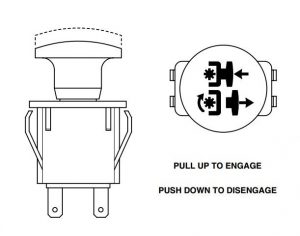
Hillside Operation
The Scag mower has been built to provide good traction and reliable stability under most natural mowing conditions. However, it’s important that you exercise caution when traveling on slopes, inclined surfaces, and wet grass since it reduces traction and diminishes steering control.
To minimize the hazard of tipping or a loss of control, do not start the mower or stop suddenly, and avoid unnecessary, steep turns. Avoid traveling at a high speed.
Remember to travel across the slope as far as possible rather than up and down the incline.
Parking the Mower
Ensure that you only park the mower on a flat and steady surface. Do not park the mower on an inclined surface. Disengage the cutting blades before parking. Once you’ve done all this, proceed to lock the neutral latches and shift the transmission lever to the neutral position. Bring the engine to the idle speed before turning the ignition to the ‘OFF’ mark and removing the key.
After Regular Usage
Wash the mower after every use. Avoid using high pressure sprays or directing the spray onto the machine’s electrical components. Never wash the engine when it is hot or running. Cold water application will also damage the mower’s engine. The safest method is to use compressed air in order to clean the engine when hot. Also keep the entire mower tidy in order to inhibit heat damage to the engine’s parts and the hydraulic oil circuit system. Check the drive belt assembly for proper, tight alignment and inspect for any signs of wear.
After waiting for the mower to cool down, fill the fuel tank with fresh, clean gasoline after every day of mowing.
Making Adjustments
Drive Control
Adjust the steering control levers such that there is a clearance of around 3-4’’ from the bottom of the mower’s rod to the very bottom of the neutral latch when the machine is in the drive position. Now you can adjust the steering and the brake rod so that the brakes don’t apply unless the steering levers have been pulled tight to all the handles. When the steering levers have been locked in the neutral setting, the machine will be able to move freely
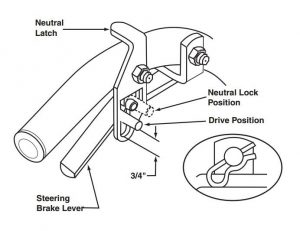
Cutter Deck Belt
First remove the belt’s cover before adjusting the cutter deck drive belts with the help of a belt tension gauge instrument. Proceed to adjust the belt so that it moves approximately 1/2″ with around 10 pounds of pressure applied. You can also adjust the tension by tightening the J-bolt or loosening it.
Continue adjusting the blade drive belt by using the belt tension instrument. Now adjust the belt in such a manner that the belt moves around 1/2″ with about the same 10 pounds of pressure. Proceed to adjust the tension after this by similarly tightening or loosening the J-bolt
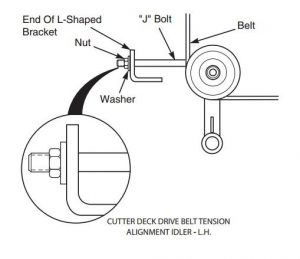
Cutting Height
The Scag mower’s deck can be adjusted to range from a height of around 1-3/4 inches to a maximum of 4-1/4 inches and can be changed at 1/4-inch intervals. Due to the many existing cutting conditions, it is also difficult to suggest an appropriate cutter deck setting which would be optimal for every lawn. There are dual adjustments that can be implemented onto the cutting deck, pitch and its height.
The height is the nominal clearance of the blade from the ground. This measurement is generally made with the cutting blades pointed sideways and distance is measured from the tip to the ground. Changes to your mower’s cutting height can be implemented by re-positioning the deck. (Adjusting this will also affect the deck’s pitch). There are three positions available. Caster spacers can also be re-positioned in order to change the cutting deck’s heights and to change the cutter deck’s pitch
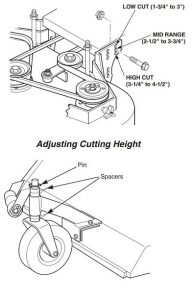
Mowing Recommendations
Avoid mowing your lawn with blunt blades. Blunt blades can increase the probability of torn grass, leading to an untidy lawn appearance. Mowing with blunt blades can also reduce mowing power. Never operate the mower without the discharge chute, mulching kit, or the entire grass catcher assembly properly fastened. The discharge chute needs to be removed and must be kept safe in the lowest operational position in order to deflect grass clippings and other thrown objects downward.
Direct the side discharge chute away from the sidewalks or streets in order to minimize cleanup of waste clippings. When mowing the mower close to obstacles, ensure that you direct the discharge away from the objects to ensure that property damage does not occur as a result of thrown objects. Cut grass only when dry and not exceedingly tall. Avoid cutting grass that is too short.
Mow your lawn frequently and make sure that the mower’s discharge chute is kept clean. When mowing wet grass or tall grass, ensure that you mow the grass twice. Raise the mower’s deck height to the highest available setting for the first mowing pass and then adjust it for the second pass to the desired mowing height. Remember to use a slow travel speed for any trimming purposes. Operate the engine only at full throttle for the best cutting experience. Mowing your lawn with at a lower RPM can cause the mower to tear grass. Remember that your engine was designed to be operated at the maximum speed.